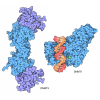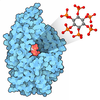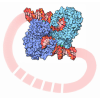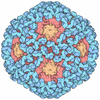+ Open data
Open data
- Basic information
Basic information
| Entry | Database: PDB / ID: 7ao9 | ||||||||||||
|---|---|---|---|---|---|---|---|---|---|---|---|---|---|
| Title | Structure of the core MTA1/HDAC1/MBD2 NURD deacetylase complex | ||||||||||||
 Components Components |
| ||||||||||||
 Keywords Keywords | TRANSCRIPTION / Deacetylase / Complex | ||||||||||||
| Function / homology |  Function and homology information Function and homology informationLoss of MECP2 binding ability to 5mC-DNA / Krueppel-associated box domain binding / Repression of WNT target genes / satellite DNA binding / MECP2 regulates transcription of neuronal ligands / protein lysine delactylase activity / p75NTR negatively regulates cell cycle via SC1 / epidermal cell differentiation / ventricular cardiac muscle tissue development / histone decrotonylase activity ...Loss of MECP2 binding ability to 5mC-DNA / Krueppel-associated box domain binding / Repression of WNT target genes / satellite DNA binding / MECP2 regulates transcription of neuronal ligands / protein lysine delactylase activity / p75NTR negatively regulates cell cycle via SC1 / epidermal cell differentiation / ventricular cardiac muscle tissue development / histone decrotonylase activity / fungiform papilla formation / NuRD complex / negative regulation of androgen receptor signaling pathway / regulation of cell fate specification / negative regulation of stem cell population maintenance / endoderm development / histone deacetylase activity, hydrolytic mechanism / siRNA binding / Transcription of E2F targets under negative control by p107 (RBL1) and p130 (RBL2) in complex with HDAC1 / histone deacetylase / maternal behavior / regulation of stem cell differentiation / protein deacetylation / Regulation of MITF-M-dependent genes involved in apoptosis / C2H2 zinc finger domain binding / STAT3 nuclear events downstream of ALK signaling / positive regulation of protein autoubiquitination / methyl-CpG binding / Transcription of E2F targets under negative control by DREAM complex / protein lysine deacetylase activity / Hydrolases; Acting on carbon-nitrogen bonds, other than peptide bonds; In linear amides / histone deacetylase activity / embryonic digit morphogenesis / positive regulation of intracellular estrogen receptor signaling pathway / DNA methylation-dependent constitutive heterochromatin formation / response to ionizing radiation / entrainment of circadian clock by photoperiod / Notch-HLH transcription pathway / negative regulation of gene expression, epigenetic / G1/S-Specific Transcription / Sin3-type complex / negative regulation of intrinsic apoptotic signaling pathway / locomotor rhythm / histone deacetylase complex / odontogenesis of dentin-containing tooth / eyelid development in camera-type eye / positive regulation of stem cell population maintenance / E-box binding / SUMOylation of transcription factors / oligodendrocyte differentiation / RNA Polymerase I Transcription Initiation / positive regulation of oligodendrocyte differentiation / G0 and Early G1 / Regulation of MECP2 expression and activity / host-mediated suppression of viral transcription / hair follicle placode formation / embryonic organ development / NF-kappaB binding / positive regulation of Wnt signaling pathway / response to mechanical stimulus / FOXO-mediated transcription of oxidative stress, metabolic and neuronal genes / Regulation of MITF-M-dependent genes involved in cell cycle and proliferation / RNA polymerase II core promoter sequence-specific DNA binding / core promoter sequence-specific DNA binding / heterochromatin / Transcriptional regulation of brown and beige adipocyte differentiation by EBF2 / Nuclear events stimulated by ALK signaling in cancer / MECP2 regulates neuronal receptors and channels / Regulation of TP53 Activity through Acetylation / cellular response to platelet-derived growth factor stimulus / transcription repressor complex / negative regulation of canonical NF-kappaB signal transduction / positive regulation of smooth muscle cell proliferation / Transcriptional and post-translational regulation of MITF-M expression and activity / RNA Polymerase I Promoter Opening / negative regulation of cell migration / SUMOylation of chromatin organization proteins / Regulation of PTEN gene transcription / transcription corepressor binding / ERCC6 (CSB) and EHMT2 (G9a) positively regulate rRNA expression / Regulation of endogenous retroelements by KRAB-ZFP proteins / hippocampus development / Deactivation of the beta-catenin transactivating complex / HDACs deacetylate histones / Regulation of endogenous retroelements by Piwi-interacting RNAs (piRNAs) / response to nutrient levels / promoter-specific chromatin binding / circadian regulation of gene expression / Downregulation of SMAD2/3:SMAD4 transcriptional activity / SMAD2/SMAD3:SMAD4 heterotrimer regulates transcription / negative regulation of transforming growth factor beta receptor signaling pathway / negative regulation of canonical Wnt signaling pathway / Formation of the beta-catenin:TCF transactivating complex / RUNX1 regulates genes involved in megakaryocyte differentiation and platelet function / NoRC negatively regulates rRNA expression / NOTCH1 Intracellular Domain Regulates Transcription / Constitutive Signaling by NOTCH1 PEST Domain Mutants / Constitutive Signaling by NOTCH1 HD+PEST Domain Mutants / histone deacetylase binding / Wnt signaling pathway Similarity search - Function | ||||||||||||
| Biological species |  Homo sapiens (human) Homo sapiens (human) | ||||||||||||
| Method | ELECTRON MICROSCOPY / single particle reconstruction / cryo EM / Resolution: 6.1 Å | ||||||||||||
 Authors Authors | Millard, C.J. / Fairall, L. / Ragan, T.J. / Savva, C.G. / Schwabe, J.W.R. | ||||||||||||
| Funding support |  United Kingdom, 3items United Kingdom, 3items
| ||||||||||||
 Citation Citation |  Journal: Nucleic Acids Res / Year: 2020 Journal: Nucleic Acids Res / Year: 2020Title: The topology of chromatin-binding domains in the NuRD deacetylase complex. Authors: Christopher J Millard / Louise Fairall / Timothy J Ragan / Christos G Savva / John W R Schwabe /  Abstract: Class I histone deacetylase complexes play essential roles in many nuclear processes. Whilst they contain a common catalytic subunit, they have diverse modes of action determined by associated ...Class I histone deacetylase complexes play essential roles in many nuclear processes. Whilst they contain a common catalytic subunit, they have diverse modes of action determined by associated factors in the distinct complexes. The deacetylase module from the NuRD complex contains three protein domains that control the recruitment of chromatin to the deacetylase enzyme, HDAC1/2. Using biochemical approaches and cryo-electron microscopy, we have determined how three chromatin-binding domains (MTA1-BAH, MBD2/3 and RBBP4/7) are assembled in relation to the core complex so as to facilitate interaction of the complex with the genome. We observe a striking arrangement of the BAH domains suggesting a potential mechanism for binding to di-nucleosomes. We also find that the WD40 domains from RBBP4 are linked to the core with surprising flexibility that is likely important for chromatin engagement. A single MBD2 protein binds asymmetrically to the dimerisation interface of the complex. This symmetry mismatch explains the stoichiometry of the complex. Finally, our structures suggest how the holo-NuRD might assemble on a di-nucleosome substrate. | ||||||||||||
| History |
|
- Structure visualization
Structure visualization
| Movie |
 Movie viewer Movie viewer |
|---|---|
| Structure viewer | Molecule:  Molmil Molmil Jmol/JSmol Jmol/JSmol |
- Downloads & links
Downloads & links
- Download
Download
| PDBx/mmCIF format |  7ao9.cif.gz 7ao9.cif.gz | 267 KB | Display |  PDBx/mmCIF format PDBx/mmCIF format |
|---|---|---|---|---|
| PDB format |  pdb7ao9.ent.gz pdb7ao9.ent.gz | 193.9 KB | Display |  PDB format PDB format |
| PDBx/mmJSON format |  7ao9.json.gz 7ao9.json.gz | Tree view |  PDBx/mmJSON format PDBx/mmJSON format | |
| Others |  Other downloads Other downloads |
-Validation report
| Summary document |  7ao9_validation.pdf.gz 7ao9_validation.pdf.gz | 1.3 MB | Display |  wwPDB validaton report wwPDB validaton report |
|---|---|---|---|---|
| Full document |  7ao9_full_validation.pdf.gz 7ao9_full_validation.pdf.gz | 1.3 MB | Display | |
| Data in XML |  7ao9_validation.xml.gz 7ao9_validation.xml.gz | 44.4 KB | Display | |
| Data in CIF |  7ao9_validation.cif.gz 7ao9_validation.cif.gz | 67.8 KB | Display | |
| Arichive directory |  https://data.pdbj.org/pub/pdb/validation_reports/ao/7ao9 https://data.pdbj.org/pub/pdb/validation_reports/ao/7ao9 ftp://data.pdbj.org/pub/pdb/validation_reports/ao/7ao9 ftp://data.pdbj.org/pub/pdb/validation_reports/ao/7ao9 | HTTPS FTP |
-Related structure data
| Related structure data |  11838MC  7ao8C  7aoaC M: map data used to model this data C: citing same article ( |
|---|---|
| Similar structure data |
- Links
Links
- Assembly
Assembly
| Deposited unit | 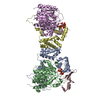
|
|---|---|
| 1 |
|
- Components
Components
-Protein , 3 types, 5 molecules CDAEB
| #1: Protein | Mass: 43323.625 Da / Num. of mol.: 1 Source method: isolated from a genetically manipulated source Source: (gene. exp.)  Homo sapiens (human) / Gene: MBD2 / Cell line (production host): HEK293 / Production host: Homo sapiens (human) / Gene: MBD2 / Cell line (production host): HEK293 / Production host:  Homo sapiens (human) / References: UniProt: Q9UBB5 Homo sapiens (human) / References: UniProt: Q9UBB5 | ||
|---|---|---|---|
| #2: Protein | Mass: 80904.312 Da / Num. of mol.: 2 Source method: isolated from a genetically manipulated source Source: (gene. exp.)  Homo sapiens (human) / Gene: MTA1 / Cell line (production host): HEK293 / Production host: Homo sapiens (human) / Gene: MTA1 / Cell line (production host): HEK293 / Production host:  Homo sapiens (human) / References: UniProt: Q13330 Homo sapiens (human) / References: UniProt: Q13330#3: Protein | Mass: 55178.906 Da / Num. of mol.: 2 Source method: isolated from a genetically manipulated source Source: (gene. exp.)  Homo sapiens (human) / Gene: HDAC1, RPD3L1 / Cell line (production host): HEK293 / Production host: Homo sapiens (human) / Gene: HDAC1, RPD3L1 / Cell line (production host): HEK293 / Production host:  Homo sapiens (human) / References: UniProt: Q13547, histone deacetylase Homo sapiens (human) / References: UniProt: Q13547, histone deacetylase |
-Non-polymers , 3 types, 8 molecules 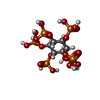




| #4: Chemical | | #5: Chemical | #6: Chemical | ChemComp-K / |
|---|
-Details
| Has ligand of interest | N |
|---|
-Experimental details
-Experiment
| Experiment | Method: ELECTRON MICROSCOPY |
|---|---|
| EM experiment | Aggregation state: PARTICLE / 3D reconstruction method: single particle reconstruction |
- Sample preparation
Sample preparation
| Component | Name: Core NuRD deacetylase complex containing two copies of MTA1 and HDAC1 and a single copy of MBD2 Type: COMPLEX / Entity ID: #1-#3 / Source: RECOMBINANT | ||||||||||||||||||||||||
|---|---|---|---|---|---|---|---|---|---|---|---|---|---|---|---|---|---|---|---|---|---|---|---|---|---|
| Molecular weight | Value: 0.17 MDa / Experimental value: YES | ||||||||||||||||||||||||
| Source (natural) | Organism:  Homo sapiens (human) Homo sapiens (human) | ||||||||||||||||||||||||
| Source (recombinant) | Organism:  Homo sapiens (human) Homo sapiens (human) | ||||||||||||||||||||||||
| Buffer solution | pH: 7.5 | ||||||||||||||||||||||||
| Buffer component |
| ||||||||||||||||||||||||
| Specimen | Conc.: 0.1 mg/ml / Embedding applied: NO / Shadowing applied: NO / Staining applied: NO / Vitrification applied: YES | ||||||||||||||||||||||||
| Specimen support | Details: 40 mA for 120 sec / Grid material: GOLD / Grid mesh size: 300 divisions/in. / Grid type: Quantifoil R1.2/1.3 | ||||||||||||||||||||||||
| Vitrification | Instrument: FEI VITROBOT MARK IV / Cryogen name: ETHANE / Humidity: 100 % / Chamber temperature: 277 K / Details: Blot for 3 seconds, blot force 10 |
- Electron microscopy imaging
Electron microscopy imaging
| Experimental equipment |  Model: Titan Krios / Image courtesy: FEI Company |
|---|---|
| Microscopy | Model: FEI TITAN KRIOS |
| Electron gun | Electron source:  FIELD EMISSION GUN / Accelerating voltage: 300 kV / Illumination mode: FLOOD BEAM FIELD EMISSION GUN / Accelerating voltage: 300 kV / Illumination mode: FLOOD BEAM |
| Electron lens | Mode: BRIGHT FIELD / Nominal magnification: 75000 X / Calibrated magnification: 129629 X / Nominal defocus min: 500 nm / Calibrated defocus min: 500 nm / Cs: 2.7 mm / C2 aperture diameter: 50 µm / Alignment procedure: COMA FREE |
| Specimen holder | Cryogen: NITROGEN / Specimen holder model: FEI TITAN KRIOS AUTOGRID HOLDER / Temperature (min): 100 K |
| Image recording | Average exposure time: 60 sec. / Electron dose: 34 e/Å2 / Detector mode: COUNTING / Film or detector model: FEI FALCON III (4k x 4k) / Num. of grids imaged: 2 / Num. of real images: 3075 |
| EM imaging optics | Phase plate: VOLTA PHASE PLATE |
| Image scans | Sampling size: 14 µm / Width: 4096 / Height: 4096 |
- Processing
Processing
| EM software |
| ||||||||||||||||||||||||||||||||||||
|---|---|---|---|---|---|---|---|---|---|---|---|---|---|---|---|---|---|---|---|---|---|---|---|---|---|---|---|---|---|---|---|---|---|---|---|---|---|
| CTF correction | Type: PHASE FLIPPING AND AMPLITUDE CORRECTION | ||||||||||||||||||||||||||||||||||||
| Particle selection | Num. of particles selected: 167389 | ||||||||||||||||||||||||||||||||||||
| Symmetry | Point symmetry: C1 (asymmetric) | ||||||||||||||||||||||||||||||||||||
| 3D reconstruction | Resolution: 6.1 Å / Resolution method: FSC 0.143 CUT-OFF / Num. of particles: 70561 / Symmetry type: POINT | ||||||||||||||||||||||||||||||||||||
| Atomic model building | Protocol: RIGID BODY FIT | ||||||||||||||||||||||||||||||||||||
| Atomic model building |
|
 Movie
Movie Controller
Controller










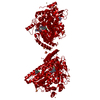
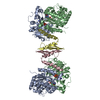
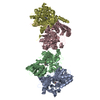


 PDBj
PDBj
